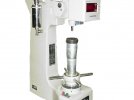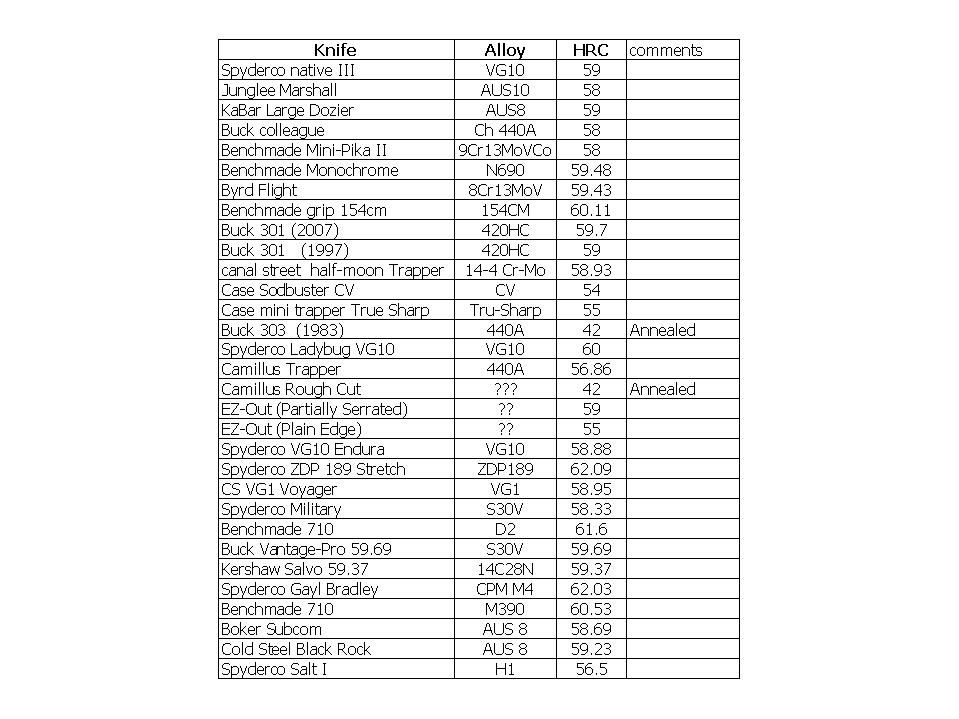Lately I am more and more interested in edge holding and cutting performance I have used a digital Rockwell tester that I have access to, to test the hardness of a number of knives that I own. 
Here are the results. Accuracy for the tester is +/-0.3 Rockwell C
Production:
OLFA LBB blades (Ultra-sharp Box cutter blades) Mfg SPpec:???? Actual: 62.3-63.1 **See post for details this may not be fully accurate**
Kershaw Boa 1580MC (CPM 440V) Mfg Spec: 55-57, Actual: 56.7
Kershaw Leek (CK&T S30V comboedge random tanto) Mfg spec: 57-59, Actual: 57.0
Kershaw Scallion (Walmart 420 HC) Mfg spec:54-56, Actual: 54.5
Kershaw RAM (14C28N) Mfg Spec:58-60, Actual: 58.7
Zero tolerance ZT 0350 (S30V) Mfg Spec: 57-59, Actual 57.7
Leatherman Juice CS4 (420HC) Mfg Spec:???, Actual: 56.8
Benchmade Snody 211 Activator (D2) Mfg Spec:60-62, Actual:60.5
Benchmade 835-07/00 KoTM (M2HS) Mfg Spec:62-64, Actual: 63.2
Benchmade 710-2 limited (M390) Mfg Spec:59-61, Actual: 62.1
Benchmade 710-2 limited (M390) Mfg Spec:59-61, Actual: 61.4
Benchmade 581 Barrage (M390) Mfg Spec:60-62, Actual: 60.1
Benchmade 710-3 (M4) Mfg spec:62-64, Actual: 62.1
Spyderco Mule MT18 (S110V) Mfg Spec:60-61, Actual: 59.7
Benchmade 940-1 (S90V) Mfg Spec: 59-61:, Actual: 59.3
Spyderco Farid K2 (10V) Mfg Spec: , Actual: 64.5
Spyderco Farid K2 (10V) Mfg Spec: , Actual: 65.0
Customs:
JW knives, Jason Woytaz (O1) Target:???, Actual: 58.6
Greg Shahan (AEB-L) Target:58, Actual 57.4
Josiah Gravelle Custom FK-SM (3V) Target:61, Actual 60.9
J Rosa Custom (S90V) Target:61, Actual 61.5
J Garrison Custom (10V) Target: 61, Actual:60.2 (on choil)
Bradford Orwell (M390) Target:61 , Actual: 62.2
Big Chris SAR (3V) Target: 60, Actual: 60.3
Big Chris Bushcrafter S90V Target: 60, Actual: 60.1
OTK DC slicer in K390 Target: 63-64, Actual: 63.3
Darrin Sanders Kiridashi (10V) Target:??? Actual: 60.6
Koster Karda 6 (3V) Target:??? Actual: 58.7
Feel free to add your own tested data.
Here are some other contributions for data points including some other models and brands.
http://www.bladeforums.com/forums/s...ion-and-custom-knives?p=11081071#post11081071
http://www.bladeforums.com/forums/s...ion-and-custom-knives?p=11238015#post11238015
The photo shows my Leatherman Juice blade with two test marks on it, and the tip of a pair of calipers set to .010" to give scale.
I also see that it needs some maintenance/sharpening.

IMG_0587 by rapt_up, on Flickr
Here are the results. Accuracy for the tester is +/-0.3 Rockwell C
Production:
OLFA LBB blades (Ultra-sharp Box cutter blades) Mfg SPpec:???? Actual: 62.3-63.1 **See post for details this may not be fully accurate**
Kershaw Boa 1580MC (CPM 440V) Mfg Spec: 55-57, Actual: 56.7
Kershaw Leek (CK&T S30V comboedge random tanto) Mfg spec: 57-59, Actual: 57.0
Kershaw Scallion (Walmart 420 HC) Mfg spec:54-56, Actual: 54.5
Kershaw RAM (14C28N) Mfg Spec:58-60, Actual: 58.7
Zero tolerance ZT 0350 (S30V) Mfg Spec: 57-59, Actual 57.7
Leatherman Juice CS4 (420HC) Mfg Spec:???, Actual: 56.8
Benchmade Snody 211 Activator (D2) Mfg Spec:60-62, Actual:60.5
Benchmade 835-07/00 KoTM (M2HS) Mfg Spec:62-64, Actual: 63.2
Benchmade 710-2 limited (M390) Mfg Spec:59-61, Actual: 62.1
Benchmade 710-2 limited (M390) Mfg Spec:59-61, Actual: 61.4
Benchmade 581 Barrage (M390) Mfg Spec:60-62, Actual: 60.1
Benchmade 710-3 (M4) Mfg spec:62-64, Actual: 62.1
Spyderco Mule MT18 (S110V) Mfg Spec:60-61, Actual: 59.7
Benchmade 940-1 (S90V) Mfg Spec: 59-61:, Actual: 59.3
Spyderco Farid K2 (10V) Mfg Spec: , Actual: 64.5
Spyderco Farid K2 (10V) Mfg Spec: , Actual: 65.0
Customs:
JW knives, Jason Woytaz (O1) Target:???, Actual: 58.6
Greg Shahan (AEB-L) Target:58, Actual 57.4
Josiah Gravelle Custom FK-SM (3V) Target:61, Actual 60.9
J Rosa Custom (S90V) Target:61, Actual 61.5
J Garrison Custom (10V) Target: 61, Actual:60.2 (on choil)
Bradford Orwell (M390) Target:61 , Actual: 62.2
Big Chris SAR (3V) Target: 60, Actual: 60.3
Big Chris Bushcrafter S90V Target: 60, Actual: 60.1
OTK DC slicer in K390 Target: 63-64, Actual: 63.3
Darrin Sanders Kiridashi (10V) Target:??? Actual: 60.6
Koster Karda 6 (3V) Target:??? Actual: 58.7
Feel free to add your own tested data.
Here are some other contributions for data points including some other models and brands.
http://www.bladeforums.com/forums/s...ion-and-custom-knives?p=11081071#post11081071
http://www.bladeforums.com/forums/s...ion-and-custom-knives?p=11238015#post11238015
The photo shows my Leatherman Juice blade with two test marks on it, and the tip of a pair of calipers set to .010" to give scale.
I also see that it needs some maintenance/sharpening.

IMG_0587 by rapt_up, on Flickr
Last edited:


